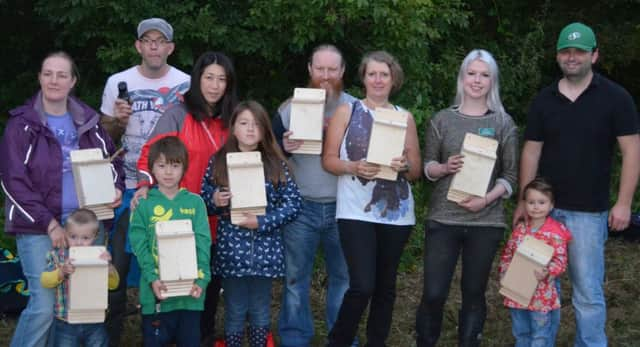‘Bat-tastic’ night at Bashfordsland Wood


Hearing and habitat were also explored as the Borough Council joined in International Bat Night on Saturday at Bashfordsland Wood.
Organiser Alison Diver, council’s biodiversity officer, explained the local authority is very keen to showcase all wildlife through initiatives such as this and the recent summer school.
Advertisement
Hide AdAdvertisement
Hide AdShe said: “Bashfordsland Wood is a great spot for our native bats, such as the common pipistrelle and brown long eared.
“At our ‘Go Batty for Bats’ evening we built bat boxes to provide extra roost sites for our native bats.
“Bats roost in tree holes and crevices, under bridges, barns, bat boxes and sometimes old houses. Bats are nocturnal so they sleep all day in their roosts and then come out to feed after sunset.
“All bats have big appetites as flying uses up a lot of energy – the tiny common pipistelle can eat over 3,000 insects in one night! So, at Bat Night we wanted to help out our bats by creating a bat garden.
Advertisement
Hide AdAdvertisement
Hide Ad“We planted a variety of plants that are very strong smelling, such as lavender, jasmine and honeysuckle as these plants attract more insects during the night which is what our bats feed on. Bats eat moths, flies, midges, mosquitoes and more. Pale coloured plants are also useful for bats are they are easier to see at night.”
After sunset, bat detectors were produced so participants could listen for the creatures.
“Bats use a sonar system called echolocation to find their way around and to find insects.” explained Alison. “Echolocation is difficult for humans to hear but with bat detectors we can hear the bat calls as clicks, squeaks and pops.
“Different bat calls have different frequencies – for example, pipistelles can be heard at 45-50kHz and Brown long eared bats at 35kHz.
Advertisement
Hide AdAdvertisement
Hide Ad“We saw and heard loads of pipistelle bats flying around which was a bat-tastic end to the evening.”
There are eight species of bat living in Northern Ireland and pipistrelles are the most common and widespread of them all.
Alison added: “They are easy to see as they are very jerky in their flight. Why not go out one night yourself to see some of our beautiful bats?”
The biodiversity summer school took place last month with several hundred people enjoying family fun projects such as pond dipping, mini-beast hunts and bird box building.